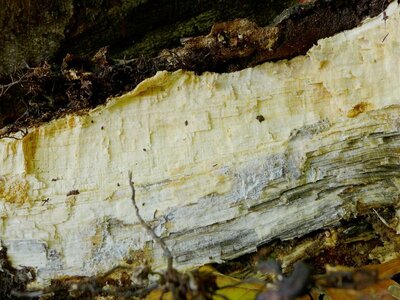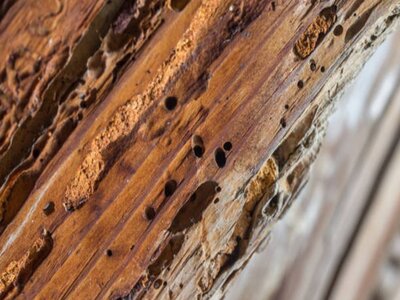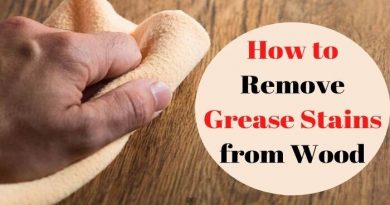How to Tell if Wood is Rotten (Easy Explained)
Does wood appear soft and rust-colored? Then there’s a big chance it’s rotten! In this article, we explain how to tell if wood is rotten, what type of wood rot exists and what cause wood rot!
What is Wood Rot?
Rotten wood is an infestation of wood caused by fungi. From the outside you don’t immediately see that the wood is affected, especially not with lacquered wood. You should therefore regularly check your wooden parts for infestation.
Wood rot is an attack on wood by fungi. Fungi in wood come from damp wood. When the wood becomes damp and cannot dry out, mold will develop. These fungi then cause the wood rot. The weather influences such as sun, rain and wind have a major influence on the occurrence of wood rot. It is therefore very common in wood that is exposed to these weather conditions.
What cause wood to rot?
The main cause of the formation of rot inside the wood is the presence of humidity which favors the proliferation of molds. Indoor humidity that exceeds twenty percent, combined with an outside temperature below five degrees, can be a good cause of rotting wood.
To this must also be added oxygen and the mold is ready to strike! The perfect habitat for molds is a humid, warm and oxygen-rich environment. Prevention, of course, is always better than cure. Fortunately, there are some rules you can keep in mind to not encourage mold growth.
Here is an easy step by step guide how to remove mold from wood!
Therefore, although the main aspects that contribute to the rotting of wood are the contact with water and moisture and the action of rotting fungi, other factors can influence the depredation of wooden parts:
- species;
- moisture;
- temperature;
- oxygen content;
- environmental conditions;
- presence of insects or microorganisms.
Rotten fungi (white rot, brown rot, soft rot), for example, release enzymes that break down the wooden cell walls of the substrate, causing physical and chemical changes and decreasing the mechanical resistance of the raw wood material.
White rot leaves the surface whitish and can cause dark lined edges. Brown rot, on the other hand, leaves a darker brown color and, when rubbed, turns into a fine powder. Finally, soft rot leaves the wood softened.
Type of Wood Rot
Brown Rot: This type of decay is caused by fungi that attack the cellulose in wood fiber, giving the damaged wood a brown tint. This is the most common form of wood deterioration caused by fungi and includes “dry rot”. Dry rot is somewhat inappropriate as it requires some moisture to be present.
The fungus has the ability to transport water through cords in affected wood, allowing it to attack apparently dry wood.
White Rot: The fungus that causes this type of rot attacks both the cellulose and lignin in the wood fiber, leaving the affected wood with a bleached appearance. White rot is most common in hardwoods, which are commonly used for floors or furniture. Soft woods are commonly used in structural applications and these are more prone to dry rot.
In general, the white rot fungus mainly reduces the compressive strength of the wood, whereas brown rot and soft rot decrease its buckling capacity. A significant loss of this resistance already occurs even before rot is detected in the wood.
You can treat wood to get rid of fungi, mold and woodworms by following this easy guide!
How to Tell if Wood is Rotten
Here’s how to tell if your wood is rotten:
| Common signs of wet wood rot | Common signs of dry wood rot |
|---|---|
| 1. Darkened wood, darker than the surrounding wood. | 1. The wood shrinks and darkens |
| 2. Soft, spongy wood with localized growth of the fungus. | 2. Wood splits in a ‘cuboidal’ fashion way |
| 3. Cracked appearance that may crumble to the touch when dry | 3. The fluffy white mycelium of ‘cotton wool’ develops under moist conditions. |
| 4. A wood shrinkage with a damp, musty smell. | 4. A silky gray wood appearance to mushroom skin often tinged with flecks of lavender |
It is important to recognize the characteristic features of rotten wood in order to provide the correct treatment. It is recognized by its color which tends to darken for rough woods, and by the peeling of the paint for those which have received coats of paint.
Signs that tell if the wood is rotten:
1.Weak points : Check the wood for weak points. If you encounter weak spots, press the blunt side of an awl or screwdriver into the spot. If the wood bounces back immediately, in most cases it is rotten wood.
2.Loosening of the paint : If the paint is loosening , it may be due to rotten wood. You should therefore carefully check the paint layer for cracks, air bubbles or flaking.
3.Discoloration of the wood : If the wood turns brown or black, this usually indicates rotten wood. If the color is light gray, the wood is still good, but moisture has already entered. Unfortunately, discoloration can only be seen on unpainted wood.
4.Rotten wood is also easily crumbled and some woods are warped or even bulging due to water saturation. The surface of the wood is covered in cracks and a carpet of moss or fungus begins to spread.
The wood begins to rot when fungi grow in its cracks and joints and it happens as soon as the moisture content of the wood reaches or exceeds 20% . This mold affects the wood, which then becomes friable and porous . You recognize that wood is rotting when it crumbles and falls apart, but also by its brown or black color and the deformation of the possible layer of paint.
Poor paint, cracks are the most common causes of mold on wood. A real nightmare for garden sheds , fences and palisades or other wooden terraces , for your garden furniture and garden benches , but also for doors and windows. Because in addition to its unsightly appearance, rotten wood also loses its strength. Fungi attack the very structure of wood.
In this easy article I will help you remove paint from wood without much effort!
Wood affected by rot tends to acquire brownish-brown spots, it is easier to identify when it shrinks in shape during drying, resulting in a cracked and cubic appearance. The cracks are perpendicular to the natural grain of the wood. When the cube-shaped wood is dry, it is very easy to crush it, it turns into powder. Brown rot produces fruiting bodies that look like scabs , shelves, or mushrooms, with a hard, woody texture when ripe.
Wood rot is the result of fungi. These fungi arise as a result of humid weather for a longer period of time, a temperature of above 18 degrees Celsius and sufficient oxygen and a breeding ground (i.e. wood).
These things shouldn’t be a problem if the woodwork is in order, but mold can develop if the woodwork is not properly protected. This is the case with open connections, unsuitable paint systems, construction faults, poor glazing that causes water ingress and untreated ends.
If you check the woodwork often, you will be better aware of changes in the wood. Wood rot can be recognized by soft spots or small cracks in the paintwork. This is usually in the corners of the frame. If you push it in with something hard, say with the back of a screwdriver, and it bounces, it probably has wood rot in it.
When any of these signs appear, you must immediately take the necessary remedy to stop the spread of the putrefaction. However, signs or not, it is mandatory to provide the exterior wood with a preventive treatment against rotting and any other attack that may affect its condition.
You can stain wood to protect it from all the pests. This is the easy guide to follow!
How to Identify White wood Rot

Once the basic type of rot brown or white is established, we can start looking for clues that will help us identify the exact rot that is causing the damage. It should also be noted that the expression “dry rot” refers only to a certain type of organism – Serpula lacrymans. All other rots are referred to as “wet wood rots”.
White Wood Rot can be recognized by the fact that the wood has a “fibrous” appearance and has a slightly lighter color (this may not be easy to observe). There is no cubic fracture as in brown rot which is prone to be more common in “hardwood type”. If the damage turns out to be due to white rot, then it is certainly not dry rot (dry rot is brown rot).
White rot degrades hemicellulose and cellulose as well as the lignin. The destruction happens in two ways. In many cases, the fungi first break down the lignin. Alternatively, they break down lignin and cellulose evenly. The order of decomposition divides the white rot into a selective and a simultaneous form. The latter is considered to be corrosion rot.
The white rot makes the wood brittle, which increases the risk of brittle fracture . As a result of the brittle fracture, the simultaneous rot or corrosion rot is similar to the brown rot: The structure of the wood is extremely brittle and fibrous.
The selective white rot is caused by fungi, which first break down wood lignin and hemicellulose. In the end, only the gray-white cellulose remains. The wood is lighter and fades quickly. The longitudinally pronounced soft, fibrous structure is typical . The wood structure is retained. Sometimes the infestation occurs in spots.
You can find the white rot mainly on living deciduous trees . But it also occurs with damp wood or built-in wooden parts on the house. If fungi infest the structure of buildings, this can lead to considerable damage.
The following types of fungi cause white wood rot:
How to Identify Brown wood Rot

Brown wood rot can be recognized by the shape of the attacked wood which fracture into a cubic shape and also gets a darker color. The “cubes” can vary in size depending on the wood and conditions, but they are usually very visible and distinct, especially when the wood dries. The affected wood turns brown. During drying, wood tends to crack perpendicular to the wood’s natural fiber (grain), resulting in cube-shaped structures that are easily crushed into powder when dried.
For gardeners and arborist (tree surgeons) , brown rot is also known as destructive rot . The decomposing fungi specialize in breaking down hemicellulose and cellulose. They destroy the structure of the wood.
In the case of brown rotten wood, there is a reduction in the bulk density as well as in the flexural strength and tensile strength of the wood.
In the course of the brown wood rot, the lignin remains slightly changed. It ensures the typical deep brown color. The lighter cellulose disappears completely as a result of the infestation. If the tree loses too much moisture, the proportion of lignin is reduced. Cracks are formed that run parallel and across and the so-called cube break cause.
When infested with brown rot, the greatest danger is the complete destruction of the tree . In the final stages, the wood crumbles like powder between your fingers. Brown rot occurs on both living and dead trees. This infestation most commonly affects coniferous woods (softwoods) .
The following types of fungi cause brown wood rot:
- Fomitopsis pinicola
- Agarikon (Laricifomes officinalis)
- Bugloss (Anchusa officinalis)
- Crab-of-the-woods (Laetiporus sulphureus)
Conclusion
In conclusion here’s how to tell if your wood is rotten:
You detect dry rot by the black or rust color of the wood. The wood is also softer in consistency and often filled with moisture. If the wood is painted, you can recognize dry rot by peeling or cracked paint.
If you think you are dealing with dry rot, knock on the wood a little. The noise is soft and spongy, so chances are it is dry rot. When you poke into the wood with a sharp tool, you immediately notice whether the wood is still hard or not.
White rot does not produce splitting, but the wood becomes paler, sometimes in pockets or streaks of varying sizes, bordering on healthy wood, and may eventually become a fibrous whitish mass. In some cases of white rot, however, the cellulose may remain intact.
FAQ
How can you tell the difference between dry rot and wet rot?
Dry rot is the most serious form of fungal decomposition in a building, scattering and destroying much of the wood. On the other hand, fungus wet rot occurs more often, but is less severe, decomposition usually stops where the wood becomes and remains wet .
How long does it take for dry rot to develop?
It is reported in laboratory culture experiments that spores can germinate between 7 to 10 days after adequate wetting; this may take longer if the spores are older. However, it appears that, in practice, under field conditions it often takes considerable time before decay becomes noticeable.




